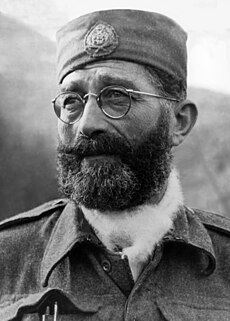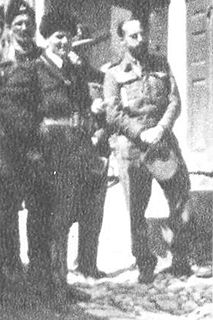Related Research Articles

Dragoljub "Draža" Mihailović was a Yugoslav Serb general during World War II. He was the leader of the Chetnik Detachments of the Yugoslav Army (Chetniks), a royalist and nationalist movement and guerrilla force established following the German invasion of Yugoslavia in 1941.

The Balkan Air Force (BAF) was an Allied air formation operating in the Balkans during World War II. Composed of units of the Royal Air Force and South African Air Force under the Mediterranean Allied Air Forces command, it was active from 7 June 1944 until 15 July 1945. Air Vice Marshal William Elliot and then George Mills, both RAF officers, were its Air Officer Commanding (AOC).

Case Black, also known as the Fifth Enemy Offensive in Yugoslav historiography and often identified with its final phase, the Battle of the Sutjeska was a joint attack by the Axis taking place from 15 May to 16 June 1943, which aimed to destroy the main Yugoslav Partisan force, near the Sutjeska river in south-eastern Bosnia. The failure of the offensive marked a turning point for Yugoslavia during World War II. It was also the last major German-Italian joint operation against the partisans.

Major-General Sir Fitzroy Hew Royle Maclean, 1st Baronet, was a Scottish soldier, writer and politician. He was a Unionist Member of Parliament (MP) from 1941 to 1974 and was one of only two men who during the Second World War enlisted in the British Army as a private and rose to the rank of brigadier, the other being future fellow Conservative MP Enoch Powell.

Eastern Approaches (1949) is a memoir of the early career of Fitzroy Maclean. It is divided into three parts: his life as a junior diplomat in Moscow and his travels in the Soviet Union, especially the forbidden zones of Central Asia; his exploits in the British Army and SAS in the North Africa theatre of war; and his time with Josip Broz Tito and the Partisans in Yugoslavia.
Vladimir "Vlatko" Velebit, PhD was a Yugoslav communist who joined the Partisans in 1941, reaching the rank of Major-General. A lawyer by profession, after the war he became a diplomat and historian.
Sir Frederick William Dampier Deakin DSO was a British historian, World War II veteran, literary assistant to Winston Churchill and the first warden of St Antony's College, Oxford.

Colonel Duane Tyrell "Bill" Hudson, was a British Special Operations Executive officer who worked as a liaison officer with the Yugoslav Partisans and Chetniks in occupied Yugoslavia during World War II.

Ivan Ribar, known as Ivo Lola or Ivo Lolo, was a Yugoslav communist politician and military leader of Croatian descent. In the 1930s, he became one of the closest associates of Josip Broz Tito, leader of the Yugoslav Communist Party. In 1936, Ribar became secretary of the Central Committee of SKOJ. During World War II in Yugoslavia, Ribar was among the main leaders of the Yugoslav Partisans and was a member of the Partisan Supreme Headquarters. During the war, he founded and ran several leftist youth magazines. In 1942, Ribar was among the founders of the Unified League of Anti-Fascist Youth of Yugoslavia (USAOJ). He was killed by a German bomb in 1943 near Glamoč while boarding an airplane for Cairo, where he was to become the first representative of Communist Yugoslavia to the Middle East Command.
Operation Typical was the name of the first World War II British mission fully assigned to Yugoslav Partisans HQ and Marshall Tito organised by the Special Operations Executive (SOE). The six soldiers flew from Derna airfield on 27 May 1943 and parachuted to Black Lake in Montenegro at the height of a large German offensive Operation Schwarz which aimed to destroy the Partisan forces. The group was led by Col William Deakin and Capt William F Stuart, together with the two radio operators - Sergeants Walter Wroughton and Peretz 'Rose' Rosenberg. Canadian-Yugoslav Ivan ('John') Starčević acted as a translator and Sgt John Campbell (RM) was a cipher clerk, and bodyguard.
In 1941 when the Axis invaded Yugoslavia, King Peter II formed a Government in exile in London, and in January 1942 the royalist Draža Mihailović became the Minister of War with British backing. But by June or July 1943, British Prime Minister Winston Churchill had decided to withdraw support from Mihailović and the Chetniks he led, and support the Partisans headed by Josip Broz Tito, even though this would result in "complete communist control of Serbia". The main reason for the change was not the reports by Fitzroy Maclean or William Deakin, or as later alleged the influence of James Klugmann in Special Operations Executive (SOE) headquarters in Cairo or even Randolph Churchill, but the evidence of Ultra decrypts from the Government Code and Cipher School in Bletchley Park that Tito's Partisans were a "much more effective and reliable ally in the war against Germany". Nor was it due to claims that the Chetniks were collaborating with the enemy, though there was some evidence from decrypts of collaboration with Italian and sometimes German forces.
Operation Hydra was a failed British attempt during World War II in Yugoslavia to develop contact with the Partisans led by Josip Broz Tito, in Montenegro in February 1942.
Launched on 1 September 1944, Operation Ratweek was a series of coordinated attacks on the axis forces communication lines in Balkans. Attack was led by the combined operations units of Yugoslav Partisans, Land Forces Adriatic, the heavy bombers of the 15th Air Force and the light and medium bombers of the Balkan Air Force.
Operation Bullseye was the code-name of the first Special Operations Executive (SOE) mission to Yugoslavia since its occupation by the Axis forces. It was led by Capt D.T. Bill Hudson with the objective to discover what was happening in Yugoslavia and co-ordinate all forces of resistance there. The mission also included three Royal Yugoslav Army (RYA) officers from Montenegro: Maj Mirko Lalatović, Maj Zaharije Ostojić and Sgt Veljko Dragićević the wireless transmitter (W/T) operator. The group boarded the submarine HMS Triumph in Malta and reached Petrovac on the Montenegrin coast on 20th Sep 1941.

Terence Atherton (1902–1942) was a British journalist and a British Special Operations Executive intelligence officer during World War II.
Mission Greenwood–Rootham was a World War II Special Operations Executive (SOE) expedition to the Yugoslav Army in the Fatherland (Chetniks) in Homolje district of Eastern Serbia near the border with Romania. The group was led by Major Erik Greenwood, Major Jasper Rootham and included Sergeant W. Anderson (W/T), Sergeant C. E. Hall (RAF) (W/T), Lieutenant E. "Micky" Hargreaves and a Royal Yugoslav Army (RYA) officer code-named "Arlo".
The Maclean Mission (MACMIS) was a World War II British mission to Yugoslav partisans HQ and Marshall Tito organised by the Special Operations Executive (SOE) in September 1943. It was led by a recently promoted Brigadier Fitzroy Maclean and was first such mission with full authorization and a personal message from Winston Churchill. His memoir of these years forms the final third of Eastern Approaches (1949).

Peretz Rosenberg was one of the early parachutists of pre-state Israel. As the radio operator of special forces leader William Deakin, he was parachuted into Yugoslavia in 1943 on a mission to reach the headquarters of Tito. After World War II, he became head of the clandestine radio service of the Haganah. Rosenberg was the inventor of many agricultural water-saving devices.
Operation Hoathley 1 was one of the two Special Operations Executive (SOE) exploratory missions to Yugoslav Partisans during the World War Two. Both Hoathley 1 and the second mission, Operation Fungus, flew out on the night of 20 Apr 1943 from Derna airfield. The missions' objective was to establish who the Partisans were, who was their leader and if and how they could be utilised to further the Allies' military ambitions. They also served as each other's backup, in case one failed to reach the Partisans or fell into enemy's hands.
Mission Rogers was a World War II Special Operations Executive (SOE) medical and military expedition to Yugoslav Partisans in Dalmatia, western Bosnia and Slovenia. The group was led by Major Lindsay Rogers and included Sergeant William (Bill) Gillanders RAMC and an RAF Sergeant Ian McGregor. Codenamed "Vaseline" the mission left southern Italy in a Royal Navy submarine and reached the island of Vis in late November 1943.
References
- ↑ Williams, p. 136
- ↑ Williams, p. 10
- ↑ Williams, p. 134
- ↑ Deakin, p. 211
- ↑ Williams, p. 127
- ↑ Williams, p. 131
- ↑ Williams, p. 137
- ↑ Deakin, p. 211
- ↑ Deakin, p. 1
- ↑ Williams, p. 134
- ↑ Williams, pp. 133-136
- ↑ Williams, p. 136
- ↑ Maclean, p. 320
- ↑ Maclaren, p. 141
- ↑ Maclean, pp. 320-321
- ↑ Williams, p. 175
- ↑ Deakin, p. 260